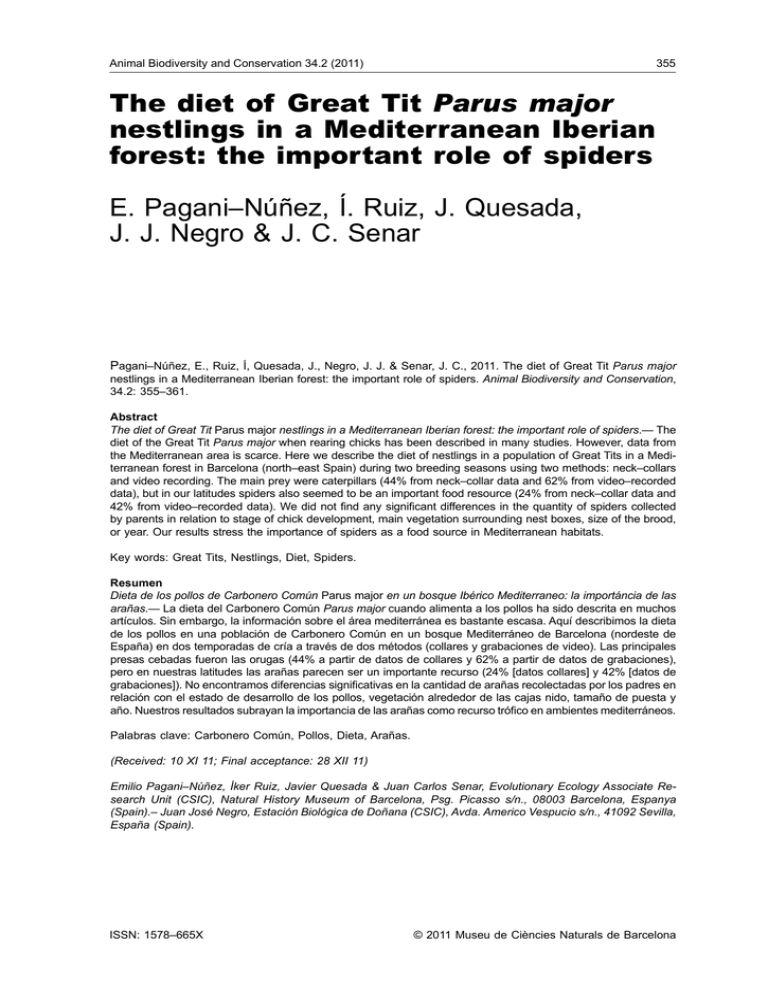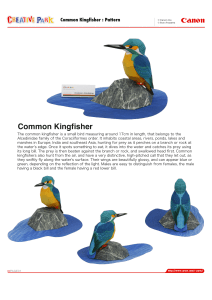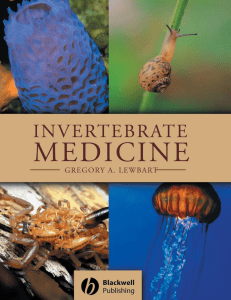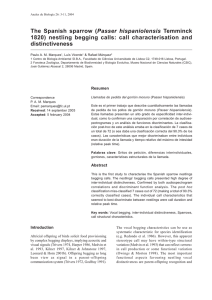The diet of Great Tit Parus major nestlings in a Mediterranean
Anuncio

Animal Biodiversity and Conservation 34.2 (2011) 355 The diet of Great Tit Parus major nestlings in a Mediterranean Iberian forest: the important role of spiders E. Pagani–Núñez, Í. Ruiz, J. Quesada, J. J. Negro & J. C. Senar Pagani–Núñez, E., Ruiz, Í, Quesada, J., Negro, J. J. & Senar, J. C., 2011. The diet of Great Tit Parus major nestlings in a Mediterranean Iberian forest: the important role of spiders. Animal Biodiversity and Conservation, 34.2: 355–361. Abstract The diet of Great Tit Parus major nestlings in a Mediterranean Iberian forest: the important role of spiders.— The diet of the Great Tit Parus major when rearing chicks has been described in many studies. However, data from the Mediterranean area is scarce. Here we describe the diet of nestlings in a population of Great Tits in a Mediterranean forest in Barcelona (north–east Spain) during two breeding seasons using two methods: neck–collars and video recording. The main prey were caterpillars (44% from neck–collar data and 62% from video–recorded data), but in our latitudes spiders also seemed to be an important food resource (24% from neck–collar data and 42% from video–recorded data). We did not find any significant differences in the quantity of spiders collected by parents in relation to stage of chick development, main vegetation surrounding nest boxes, size of the brood, or year. Our results stress the importance of spiders as a food source in Mediterranean habitats. Key words: Great Tits, Nestlings, Diet, Spiders. Resumen Dieta de los pollos de Carbonero Común Parus major en un bosque Ibérico Mediterraneo: la importáncia de las arañas.— La dieta del Carbonero Común Parus major cuando alimenta a los pollos ha sido descrita en muchos artículos. Sin embargo, la información sobre el área mediterránea es bastante escasa. Aquí describimos la dieta de los pollos en una población de Carbonero Común en un bosque Mediterráneo de Barcelona (nordeste de España) en dos temporadas de cría a través de dos métodos (collares y grabaciones de video). Las principales presas cebadas fueron las orugas (44% a partir de datos de collares y 62% a partir de datos de grabaciones), pero en nuestras latitudes las arañas parecen ser un importante recurso (24% [datos collares] y 42% [datos de grabaciones]). No encontramos diferencias significativas en la cantidad de arañas recolectadas por los padres en relación con el estado de desarrollo de los pollos, vegetación alrededor de las cajas nido, tamaño de puesta y año. Nuestros resultados subrayan la importancia de las arañas como recurso trófico en ambientes mediterráneos. Palabras clave: Carbonero Común, Pollos, Dieta, Arañas. (Received: 10 XI 11; Final acceptance: 28 XII 11) Emilio Pagani–Núñez, Íker Ruiz, Javier Quesada & Juan Carlos Senar, Evolutionary Ecology Associate Research Unit (CSIC), Natural History Museum of Barcelona, Psg. Picasso s/n., 08003 Barcelona, Espanya (Spain).– Juan José Negro, Estación Biológica de Doñana (CSIC), Avda. Americo Vespucio s/n., 41092 Sevilla, España (Spain). ISSN: 1578–665X © 2011 Museu de Ciències Naturals de Barcelona Pagani–Núñez et al. 356 Introduction The Great Tit Parus major has often been used as a model species in studies of feeding behaviour and diet (Royama, 1970; Wansink & Tinbergen,1994; Biard et al., 2006; Senar et al., 2010). Although some variation appears between areas and periods, the species has been reported to focus highly on caterpillars when rearing chicks (Gibb & Betts, 1963; Balen, 1973; Gosler, 1993; Wilkin et al., 2009). Nevertheless, the species has also been recorded to provide other animal content such as butterflies, Phasmidae or Orthoptera. Interestingly, high proportions of spiders have been reported early in the chicks’ diet, with a peak around 5–6 days of age (see Ramsay & Houston [2003] for references). These results are independent of date and habitat, which stresses that Tits specifically select spiders in their diet during that period. This preference for arachnids has also been recorded for other similar species such as Blue Tits Cyanistes caeruleus (Banbura et al., 1999; Arnold et al., 2007; Arnold et al., 2011; Garcia–Navas & Sanz, 2011), Pied Flycatchers Ficedula hipoleuca (Sanz, 1998) and Red–Breasted Flycatchers Ficedula parva (Mitrus et al., 2010). Earlier work found that the proportion of spiders increased markedly in Mediterranean habitats, with this food resource being used right throughout the breeding period. Blondel et al. (1991) reported that although the percentage of spiders in Blue Tit diets was about 16% in the mainland, it rose to 26% in the islands. Naef–Daenzer et al. (2000) found that the percentage of spiders in very earlier stages of Great Tit chick development could rise to 75%, although it rapidly decreased again to 5%. The aim of this work was to analyse in detail the relative contribution of spiders to the diet of Great Tit nestlings in a typical Mediterranean forest. We analysed the diet in relation to spider availability and Great Tit breeding phenology. Specifically, we aimed 1) to assess whether Great Tits actively selected prey to feed their brood; 2) to determine if there were any differences in the quantity of spiders provided to nestlings by parents in relation to the age of the nestlings, brood size and forest structure; and 3) to determine if there were any differences in the quantity of spiders provided to nestlings according to the sex of the parents. Material and methods Great Tits were studied over two breeding seasons in 2001 and 2004, in a mixed forest dominated by oaks and pines in the field station of Can Catà, within the Park of Collserola (Cerdanyola, Barcelona, NE of the Iberian Peninsula, latitude 45º 27' N, length 2º 8' E). Nest boxes were distributed throughout the whole area (80 ha). They were located on the trunks of oaks, at an approximate height of 1.30 m. Birds entered the nest boxes through a cylindrical tube of 10 cm in length and 5 cm in diameter designed to protect the box from predators. The study area was highly varied. Altitude ranged from 80 to 225 m a.s.l. At the bottom of the valley vegetation coverage was dominated by Holm Oaks (Quercus ilex) and Oaks (Quercus cerrioides) and had a highly developed Mediterranean understory. On the slopes the Aleppo Pine (Pinus halepensis) was the predominant tree species. We considered the nest boxes in accordance with the main vegetation surrounding them. We considered two zones, the valley, where Quercus trees represented > 70% of the arboreal vegetation, and the slopes, where pines showed higher presence the higher the altitude and Quercus trees represented < 70% of the arboreal vegetation. Recording diet: filming The diet provided by Great Tit parents to their chicks was studied in spring 2001 by filming the parents’ entries and exits from the nest box. Filming was undertaken using a domestic video camera that was camouflaged by means of a net of cryptic colours and vegetation at five meters‘distance from the box. The tapes had an hour of duration. Three days before filming we placed a tripod on the ground in the exact position where we later filmed to get the birds used to the setting. The height of the camera with the tripod did not surpass 50 cm above ground level. Wire netting was placed over the entrance of the nest–box to make it more difficult for the birds to enter the box. This delayed their entry, allowing a clear view of each prey item (Currie et al., 1996; Atienzar et al., 2009). The nest boxes were checked twice each week to gather breeding data, including laying date, clutch size, hatching date, numbers of nestlings and fledglings. We eliminated tapes that recorded fewer than five visits by the male, since we considered they could be biased in some way. This left us with a sample size of 25 nest boxes. Tape recordings allowed us to determine the sex of the parents and the exact time of each feeding. The method provides a photographic record of the prey items for later identification and is not biased by the size of the prey. Prey are sometimes difficult to identify, however (Barba & Monrós, 1999). Neck collars Diet was analysed in spring 2004 using neck collars (Barba & Gil–Delgado, 1990). Neck collars allow simultaneous gathering of samples from several nests. Collars were made from a wire cable, and the loop was carefully laid around the neck of the chick, allowing it to breathe unhindered, but unable to swallow food (Poulsen & Aebischer, 1995). Collars remained fitted for two hours. We sampled a total of 37 nest boxes. The food was carefully extracted from the mouth and oesophagus of the chick, and the neck collar was removed. The food was suitably stored in individual vials and the number on the box and date were noted. The mass of each sample was later measured in the lab. We recorded the diet of chicks using this method when they were Animal Biodiversity and Conservation 34.2 (2011) 357 Table 1. Arthropod abundance in leaves of trees in the study area. We surveyed fifteen trees of each the tree main species (Holm Oaks, Quercus ilex; Oaks, Quercus cerrioides; and Aleppo Pine, Pinus halepensis) on the slopes and at the bottom of the valley. Census made during springs in 2002 and in 2003. Table 1. Abundancia de artrópodos en las hojas de los árboles de la zona de estudio. Se testaron quince árboles de cada una de las tres espécies principales (encinas, Quercus ilex; robles, Quercus cerrioides y pino carrasco, Pinus halepensis) en las laderas y los fondos del valle. El censo se realizó durante las primaveras de 2002 y 2003. Prey Lepidoptera larvae Symphita larvae N N / tree St. Dev % N V (mm3) % Mass 156 0.06 0.29 6.35 600 42.90 89 0.03 0.31 3.62 450 18.36 168 0.07 0.84 6.84 150 11.55 Orthoptera 71 0.03 0.2 2.89 300 9.76 Coleoptera 448 0.18 0.55 18.23 20 4.11 Lepidoptera adults Arachnida 397 0.16 0.53 16.16 20 3.64 Chrysalis 10 0 0.07 0.41 750 3.44 Tipulae 53 0.02 0.17 2.16 120 2.92 119 0.05 0.28 4.84 20 1.09 Homoptera Phasmida 3 0 0.03 0.12 600 0.83 Neuroptera 25 0.01 0.1 1.02 50 0.57 Formicidae 481 0.19 1.42 19.58 2 0.44 Mantidae 1 0 0.02 0.04 Heteroptera 1 0 0.02 0.04 Myriapoda 1 0 0.02 0.04 Gasteropoda 1 0 0.02 0.04 both five and twelve days old, to analyse changes in the feeding behaviour in relation to the age of the nestlings. Using this method it is not possible to determine which of the parents deliver every item (Barba & Monrós, 1999). We used both video filming and neck collar data to characterize the nestling diet and to determine which variables could affect the quantity of spiders provided to nestlings by Great Tit parents. (2, 20, 120, 150, 300, 450, 600 and 750 mm3). The mass equivalence was obtained by multiplying volume by abundance. This allowed us to evaluate the abundance of the different groups of arthropods present in the forest and to assess whether there was any active selection of prey by the parents. Phenology of prey Arthropod census on trees During the breeding seasons of the years 2002 and 2003 we made a census of arthropods present in the leaves of the three main tree species at Can Catà: Holm Oaks (Quercus ilex), Oaks (Quercus cerrioides), and Aleppo Pine (Pinus halepensis). We randomly selected fifteen trees of each species for each year, ten located on the slopes and five at the bottom of the valley; this allowed us to take altitudinal variations into account. Census lasted four minutes per tree. We recorded all insects seen on external branches and leaves (Carrascal et al., 1998). Arthropod volume was estimated and classified into one of eight sizes Census of arthropods on tree leaves showed that the groups most frequently recorded were Formicidae (20%), Coleoptera (18%), and Arachnidae (16%). Lepidoptera represented 13% of the records (larvae 6%, adults 7%). When we considered the volume (mm3) as a proxy for the biomass of the prey delivered, however, their relative importance changed: Lepidoptera became the main prey available (larvae 43%, adults 12%), followed by Symphyta (larvae 18%, adults were not found) and Orthoptera (10%); many other taxa were recorded but their frequencies were very low (table 1). Results Pagani–Núñez et al. 358 70% Collected prey 60% Filming Collars 50% 40% 30% 20% 10% 0 Caterpillars Spiders Others Fig. 1. Percentage of prey collected by Great Tit parents, according to the recording method: video (2001) or neck collars (2004). Fig. 1. Porcentaje de presas recolectadas por los padres de Carbonero Común, de acuerdo con el método de grabación: vídeo (2001) o collares (2004). Prey brought by parents to nestlings Great Tits brought a variety of insects to the nest: caterpillars (both Lepidoptera and Symphyta), spiders (including also eggs), butterflies, Phasmidae, Orthoptera and formless remains. Caterpillars included Symphyta such as Diprion sp.; Noctuidae such as Orthosia sp., Catocala sp. and Spodoptera sp.; Geometridae such as Lycia sp. and Idaea sp.; hairy caterpillars such as Lymantria sp. and Orgyia sp. Spiders included mainly Zoropsis sp., Olios sp., Gibbaranea sp., Scotophaeus sp., Chiracantium sp., Philodromus sp., Synema sp. and Thomisius sp. We grouped prey in three groups: caterpillars, spiders and 'others'. Data obtained from filming nests showed that caterpillars were the main prey provided to nestlings (44%), followed by spiders (42%) (fig. 1). Frequencies did not correspond to availability, since caterpillars and spiders were consumed more than expected when compared to other insects (x2 = 360.55; df = 2; P < 0.005). When we compared consumption to availability only for caterpillars and spiders we found that caterpillars were consumed more than expected (x2 = 13.73; df = 1; P [ 0.005). Data obtained from neck collars showed caterpillars and butterflies were the main (62%) groups of prey brought by the parents to the nestlings. In the second place we found spiders (24%). The remaining arthropods were present at very low frequencies (fig. 1). Again, frequencies did not correspond to availability, since caterpillars and spiders were also more frequently consumed than expected (x2 = 375.55; df = 2; Table 2. MANOVA of quantity of spiders provided by parents to their nestlings according to their age (5 and 12 days old). We included also as factors the size of the brood and the percentage of Quercus surrounding (25 m) nest boxes (measured in a qualitative scale: > 70% and < 70% of Quercus). Tabla 2. MANOVA de la cantidad de arañas proporcionada por los padres a sus crías en función de su edad (5 y 12 días). Se incluyeron también como factores el tamaño de puesta y el porcentaje de Quercus cercanos a las cajas nido (25 m) (medido en una escala cualitativa: > 70% y < 70% de Quercus). F1,16 P % Quercus 0.3 0.57 Brood size 0.5 0.48 Age of the nestlings 3.0 0.10 % Quercus x brood size 0.4 0.52 Age nestlings x % Quercus 1.0 0.33 Age nestlings x brood size 1.8 0.20 Age nestlings x brood size x x % Quercus 0.4 0.51 Animal Biodiversity and Conservation 34.2 (2011) 80% 70% % spiders P < 0.005). When we considered only caterpillars and spiders, we found that caterpillars were ingested more often than expected according to availability (x2 = 63.64; df = 1; P < 0.005). Collar data showed that the quantity of spiders provided to nestlings by Great Tit parents did not vary with the age of the nestlings, brood size or forest structure, measured as a percentage of Quercus around the nest (table 2). Video data showed that females provided young with more spiders than males (fig. 2), and that males provided more caterpillars than females (tables 3, 4). However, in absolute terms, males provided more prey items than females, including spiders (table 3). Repeated measures ANOVA within each pair stressed that the males collected more caterpillars whereas females tended to deliver more spiders (table 4). When comparing abundance and selection of caterpillars and spiders in function of sex, we found that males seemed to actively select caterpillars (x2 = 15.18; df = 1; P < 0.005), but females did not (x2 = 0.08; df = 1; P = 0.77). Analyses of pooled data from both recording methods showed no relationship between the quantity of spiders fed by the parents and the factors 'method/year', 'size of brood' or 'habitat structure' measured as percentage of Quercus around the nest (table 5). 359 60% 50% 40% 30% 20% Males Females Fig. 2. Mean percentage and 95% confidence intervals of spiders fed to young by males and females during the 2001 breeding season, according to video data (see table 4). Fig. 2. Porcentaje medio e intérvalos de confianza del 95% de las arañas que alimentan a los jóvenes recolectadas por los machos y hembras durante la temporada de cría de 2001, según grabaciones de vídeo (ver tabla 4). Discussion Table 3. Percentage and absolute values of different preys collected by Great Tit males (n = 25) and females (n = 22) during the 2001 breeding season (filming data). Tabla 3. Porcentaje y valores absolutos de las distintas presas recolectadas por machos (n = 25) y hembras (n = 22) de Carbonero Común durante la temporada de cría 2001 (grabaciones de video). Percentage N Caterpillars 48.96% 94 Spiders 40.63% 78 Others 10.42% 20 100% 192 Males Sum Females Caterpillars 35,56% 32 Spiders 55.56% 50 Others 8.89% 8 Sum 100% 90 Caterpillars are generally the main food resource used by Tits to feed their chicks (Sillanpaa et al., 2008; Wilkin et al., 2009). Nevertheless, several studies have pointed out the important role of spiders as a key resource during the early stages of chick development (Ramsay & Houston, 2003), when spiders may Table 4. RM ANOVA comparing males and females within each nest–box in relation to the number of caterpillars and spiders collected. Data recorded during the 2001 breeding season (filming data). Tabla 4. RM ANOVA comparando machos y hembras dentro de cada caja nido en relación con el número de orugas y arañas recolectados. Datos registrados durante la temporada de cría 2001 (grabaciones de vídeo). Caterpillars Spiders F1,17 P 11.1 < 0.001 3.5 0.08 Pagani–Núñez et al. 360 Table 5. ANOVA on the variation in the abundance of spiders collected by Great Tit parents in relation to the recording method (collars and filming data), percentage of Quercus surrounding nest boxes (categorical variable with two classes: > 70% and < 70% of Quercus) and size of the brood. Tabla 5. ANOVA de la variación en la abundancia de las arañas recolectadas por los padres de Carbonero Común en relación con el método de grabación (collares y grabaciones de video), porcentaje de Quercus que rodean los nidos (variable categórica con dos clases: > 70% y < 70% de Quercus) y tamaño de puesta. F1,57 P Method 9.0 0.20 Brood size 3.1 0.33 % Quercus 09 0.52 Method x brood size 3.4 0.32 Method x % Quercus 1.5 0.43 Brood size x % Quercus 0.6 0.59 Method x nº brood x x % Quercus 0.2 0.69 constitute 25% of the nestlings’ diet (Tinbergen, 1960; Royama, 1970; Balen, 1973; Cowie & Hinsley, 1988, Woodburn, 1997). Our data stress that the overall contribution of spiders to the diet of the nestling Tits is even higher in the Mediterranean ecosystems, where figures can rise to 25 or even 40%, independently of the age of the chicks (see also Blondel et al., 1991; Naef–Daenzer, 2000). It could be argued that the higher use of spiders as a food source in this area is a collateral result of the generalized lack of food and the harder conditions of the Mediterranean forests (Royama, 1970; Blondel et al., 1991). However, the high proportion of spiders fed to the nestlings in our study area, independently of location and habitat structure, suggests that spiders may also be selected as a main food source. Additionally, if we consider the volume of prey rather than frequency, the availability of caterpillar increases greatly, implying that spiders are a more favoured food resource. Further, more detailed data on the size of the prey brought to nestlings is needed, however, to confirm this consideration. Variations found over the two years of the study may be due to yearly variations or, more probably, to differences in the recording method used. Small spiders may easily be ingested by chicks when collars are used, and videotaping is probably a less biased recording method (Barba & Monrós, 1999). Another important pattern found was that males and females provided different quantities of spiders to their nestlings, with females capturing a higher percentage of spiders. Sexual differences in the use of spiders has not been previously documented in Great Tits (Atienzar et al., 2009; Garcia–Navas & Sanz, 2010; Mitrus et al., 2010), although the pattern is consistent with results found by Grieco (2001), who stated that female Blue Tits were more flexible in relation to their feeding behaviour, while males maintained a constant proportion of food components between years. Differences between sexes may be determined by sex–differential strategies in feeding, or even, foraging behaviour (Tschirren et al., 2005). Nevertheless, we should point out that even though females provided a higher proportion of spiders than males, figures reversed when we analysed absolute values, so that males provided in general higher quantities of food, including spiders. Our results contrast with Wright & Cuthill (1990) and Mitrus et al. (2010) who reported higher feeding rates for females. This means that males are responsible for an important part of chick provisioning and development in our population. Future studies should assess whether the active selection of spiders in the Mediterranean is constant through the different stages within the life–history of the species (e.g., when moulting or breeding) or with the age of the birds. Finally, given the nutritional value of spiders due to their high content in taurine (Ramsay & Houston, 2003), it would be interesting to determine the extent to which their preferential selection in the Mediterranean area can have physiological consequences for the Great Tits. Acknowledgements The present study was funded by CGL2009–10652 research project to JCS and JJN, and by FPI grants BES2010–040359 to EPN, from the Ministry of Science and Innovation, Spanish Research Council. Birds were handled with the permission of the Catalan Ringing Office (ICO) and the Departament de Medi Ambient, Generalitat de Catalunya. We thank the owners of Can Catà for kindly allowing us to use their facilities. We also thank J. A. Barrientos for his help with the identification of Arthropods. References Arnold, K. E., Ramsay, S. L., Donaldson, C. & Adam, A., 2007. Parental prey selection affects risk–taking behaviour and spatial learning in avian offspring. Proceedings of the Royal Society B–Biological Sciences, 274: 2563–2569. Arnold, K. E., Ramsay, S. L., Henderson, L. & Larcombe, S., 2011. Seasonal variation in diet quality: antioxidants,invertebrates and Blue Tits Cyanistes caeruleus. Biol. J. Linn. Soc., 99: 708–717. Atienzar, F., Andreu, J., Alvarez, E. & Barba, E., 2009. An improved type of wire cage for the study of parental feeding behaviour in hole–nesting pas- Animal Biodiversity and Conservation 34.2 (2011) serines. Revista Catalana d’Ornitologia, 25: 26–31. Balen, J. H. V., 1973. A comparative study of the breeding ecology of the Great Tit Parus major in different habitats. Ardea, 61: 1–93. Banbura, J., Lambrechts, M., Blondel, J., Perret, P. & Cartanson, M., 1999. Food handling time of Blue Tits chicks: constraints and adaptations to different prey tipes. J. Avian Biol., 30: 263–270. Barba, E. & Gil–Delgado, J. A., 1990. Seasonal variation in nestling diet of the Great Tit Parus major in orange groves in eastern spain. Ornis Scand., 21: 296–298. Barba, E. & Monrós, J. S., 1999. Métodos de estudio de la alimentaciónen pollos de paseriformes: Una revisión. EtoloGuía, 17: 31–52. Biard, C., Surai, P. F. & Moller, A. P., 2006. Carotenoid availability in diet and phenotype of Blue and Great Tit nestlings. J. Exp. Biol., 209: 1004–1015. Blondel, J., Dervieux, A., Maistre, M. & Perret, P., 1991. Feeding ecology and life history variation of the Blue Tit in Mediterranean deciduous and sclerophyllous habitats. Oecologia, 88: 9–14. Carrascal, L. M., Senar, J. C., Mozetich, I., Uribe, F. & Domènech, J., 1998. Interactions among environmental stress, body condition, nutritional status, and dominance in Great Tits. Auk, 115: 727–738. Cowie, R. J. & Hinsley, S. A., 1988. Feeding ecology of Great Tits Parus major and Blue Tits Parus caeruleus breeding in suburban areas. J. Anim. Ecol., 57: 611–626. Currie, D., Nour, N. & Adriaensen, F., 1996. A new technique for filming prey delivered to nestlings, making minimal alterations to the nest box. Bird Study, 43: 380–382. Garcia–Navas, V. & Sanz, J. J., 2010. Flexibility in the Foraging Behavior of Blue Tits in Response to Short–Term Manipulations of Brood Size. Ethology, 116: 744–754. – 2011. The importance of a main dish: nestling diet and foraging behaviour in Mediterranean Blue Tits in relation to prey phenology. Oecologia, 165: 639–649. Gibb, J. A. & Betts, M. M., 1963. Food and Food Supply of Nestling Tits (Paridae) in Breckland Pine. J. Anim. Ecol., 32: 489–533. Gosler, A. G., 1993. The Great Tit. Hamlyn, London. Grieco, F., 2001. Short–term regulation of food–provisioning rate and effect on prey size in Blue Tits, 361 Parus caeruleus. Anim. Behav., 62: 107–116. Mitrus, C., Mitrus, J. & Sikora, M., 2010. Changes in nestling diet composition of the Red–Breasted Flycatcher Ficedula parva in relation to chick age and parental sex. Animal Biology, 60: 319–328. Naef–Daenzer, L., Naef–Daenzer, B. & Nager, R. G., 2000. Prey selection and foraging performance of breeding Great Tits Parus major in relation to food availability. J. Avian Biol., 31: 206–214. Poulsen, J. G. & Aebischer, N. J., 1995. Quantitative Comparison of Two Methods of Assessing Diet of Nestling Skylarks Alauda arvensis. The Auk, 112(4): 1070–1073. Ramsay, S. L. & Houston, D. C., 2003. Amino acid composition of some woodland arthropods and its implications for breeding Tits and other passerines. Ibis, 145: 227–232. Royama, T., 1970. Factors governing hunting behaviour and selection of food by Great Tit Parus major. J. Anim. Ecol., 39: 619–668. Sanz, J. J., 1998. Effect of habitat and latitude on nestling diet of Pied Flycatchers Ficedula hypoleuca. Ardea, 86: 81–88. Senar, J. C., Moller, A. P., Ruiz, I., Negro, J. J., Broggi, J. & Hohtola, E., 2010. Specific appetite for carotenoids in a colorful bird. Plos ONE 5: e10716 Sillanpaa, S., Salminen, J. P., Lehikoinen, E., Toivonen, E. & Eeva, T., 2008. Carotenoids in a food chain along a pollution gradient. Science of the Total Environment, 406: 247–255. Tinbergen, L., 1960. The natural control of insects in pinewoods. Arch. Néerl. Zool., 13: 259–379. Tschirren, B., Fitze, P. S. & Richner, H., 2005. Carotenoid–based nestling colouration and parental favouritismin the Great Tit. Oecologia, 143: 477–482. Wansink, D. & Tinbergen, J. M., 1994. The influence of ambient temperature on diet in the Great Tit. Journal of Avian Biology, 25: 261–267. Wilkin, T. A., King, L. E. & Sheldon, B. C., 2009. Habitat quality, nestling diet, and provisioning behaviour in Great Tits Parus major. J. Avian Biol., 40: 135–145. Woodburn, R., 1997. Breeding ecology of the blue tit and great tit and the possible effects of climate change. Ph. D. Thesis, Oxford University. Wright, J. & Cuthill, I., 1990. Manipulation of sex differences in parental care: the effect of brood size. Anim. Behav., 40: 462–471.



